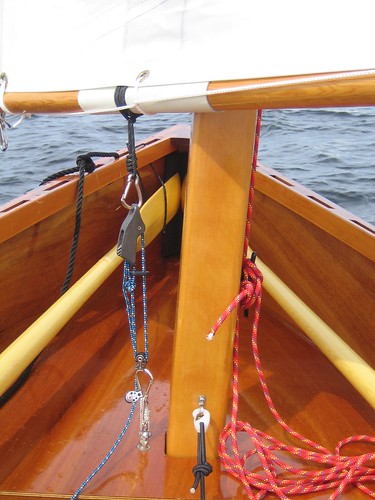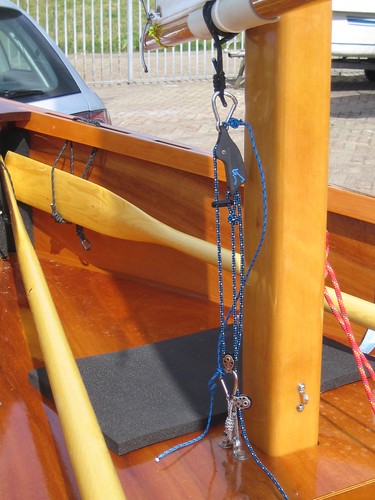 Thanks: 0
Thanks: 0
 Likes: 0
Likes: 0
 Needs Pictures: 0
Needs Pictures: 0
 Picture(s) thanks: 0
Picture(s) thanks: 0
Results 16 to 30 of 42
-
21st September 2009, 08:09 PM #16

Hmmmm.... strong winds.... down-wind... full sail.... flat bottom ....
Rodeo sounds about right.
With the flat bottom, I imagine GIS could be fairly tippy at speed and downwind without sideways
sail pressure to steady things. Rather like the skiffs that her performance emulates.
Might want to reef a bit earlier if you want to keep things relaxed and calm ?
cheers
AJ
-
21st September 2009 08:09 PM # ADSGoogle Adsense Advertisement
- Join Date
- Always
- Location
- Advertising world
- Age
- 2010
- Posts
- Many
-
22nd September 2009, 01:15 AM #17
 SENIOR MEMBER
SENIOR MEMBER











- Join Date
- Apr 2008
- Location
- Tilburg, the Netherlands
- Age
- 51
- Posts
- 519

Hello,
My experiences with the GIS running in strong winds (steady Force 5) and a good swell from behind are very different: I find the GIS a very stable craft that is very balanced on her rudder with predictable reactions to any rudder movement.
Three things that I am very careful about:
1. Not to let the yard go beyond the mast (stopper knot as described by Watermaat to prevent the boom and yard going out too much)
2. Lift the dagger board as much as possible: the boat will start rolling when you overdo it but if prevents the boat from tripping (attached picture of the daggerboard shows an elastic band that attaches to a small saddle on the mast. This elastic band keeps the board in the set position either up or down).
3. Lots of downhaul tension! (see attached picture that shows my way of rigging this).
Best wishes,
Joost
P.S. Early reefing also helps of course. One thing that I have noticed is that she won't go much slower than anyway.


Last edited by Joost; 22nd September 2009 at 01:17 AM. Reason: Addition of P.S.
-
22nd September 2009, 03:09 AM #18
 Novice
Novice











- Join Date
- Feb 2009
- Location
- Berlin
- Posts
- 10

Hello Joost,
I've just been out with my Goat. Very calm wind. Put the stopper-knot in, a practical thing to have! Will try a downhaul-system as shown in your photo. It looks like a lot of tension can be applied that way. And I did not have sorted out the line that holds the centre-board out of its case. Will also improve this point.
By the way: thank you for the inspiring report on your race in Scotland!
Fabian
-
22nd September 2009, 09:58 AM #19
 SENIOR MEMBER
SENIOR MEMBER











- Join Date
- May 2008
- Location
- Portland, ME USA
- Posts
- 837

A way I keep my daggerboard in the up position on my small sailing dinghy is a bungee that is held fast on the aft side of the board and when I pull it up and over the board it's tension wedges itself on the forward edge and keeps the board up. Really simple. I would think it'd work just as well. The only issue I see with Joost's arrangement is that when singlehanding you'd have to go all the way forward to hook the bungee on the mast. With crew, no problem.
-
22nd September 2009, 11:57 AM #20

Redback's solution to the dagger board, suggested by Mik, is a loop of shock cord. I slip the loop around the mast when putting it up and slide the dagger board down through the loop - simple and gives that tension. Of course, 'having to go forward' isn't an issue on Redback, she being less than half the length of the GIS to start with

Richard
-
23rd September 2009, 06:42 PM #21

David Graybeal has a loop that goes over the top of the board from either side of the centrecase.
At Timothy Lake instead of releasing it over the top of the board to hold it in the case I pulled it around and over the front. This holds it at any height desired, however the negative effect is that it pulls the top of the board back and the leading edge forward. A bit less than ideal.
I think if a loop was positioned with the two ends attached to the centrecase front spacer (through the centrecase sides) about half way down the middle would pull back and snap over the back edge of the centreboard.
Might take some fiddling but seems possible after playing with David's setup.
MIK
-
25th September 2009, 09:18 AM #22
 Senior Member
Senior Member











- Join Date
- Aug 2008
- Location
- Denmark
- Posts
- 198

Hey Joost
Dont there get too much tension when the bom goes the other way around ?
It seems that there already is a lot of tension and when the bom swing then there must be even more tension
But i really like your way to do it, its one of the big problem i have with my GIS
I cant see that you have attached the bom to the mast - dont it get to far away from the mast ?
Best Regards
Bjarne
-
25th September 2009, 07:49 PM #23

Hi Joost,
Bjarne and I noticed that you've dispensed with the boom tether to the mast?
-
26th September 2009, 03:47 AM #24
 SENIOR MEMBER
SENIOR MEMBER











- Join Date
- Apr 2008
- Location
- Tilburg, the Netherlands
- Age
- 51
- Posts
- 519

Hello Bjarne, Bruce,
I don’t use the tether for the following reasons:
1. With the square mast the tether has to be quite loose to allow the boom to move freely
2. The downhaul sufficiently keeps the boom near the mast. I have tried the tether, but as it needs to be quite loose as described under 1, it loses its function completely as the downhaul kicks in before the tether does.
3. The downhaul system I use is plenty strong (harken 16 mm blocks, dyneema lines, etc.) to withstand the forces applied and it allows for easy and fast adjustment depending upon wind force. The karabiners make for easy and fast unclipping of the downhaul.
4. I don’t like the downhaul line to go over the top of the boom as it can interfere with the boom swinging from one side to the other side in light winds. My system allows for easy pivoting.
Hope this helps.
Regards,
Joost
-
26th September 2009, 07:14 AM #25

-
26th September 2009, 08:40 AM #26
 SENIOR MEMBER
SENIOR MEMBER











- Join Date
- Apr 2008
- Location
- Tilburg, the Netherlands
- Age
- 51
- Posts
- 519

Hello,
Is this question for Bjarne or for me?
The mastpartner on GISwerk has been reinforced with a big epoxy fillet on the front (first) bulkhead and a piece of mahogany on the aft side of the mastpartner glued over the last bit of the mastpartner and the framework on the aft (second) bulkhead with again some fillets reinforcing the structure.
The saddle is bolted through with 7 mm stainless steel bolts, the ply deck is glued in place with fillets on the side. In my opinion plenty strong to handle the loads.
I must say that I don't really understand your concerns here: yes, with the system I have you can put decent tension on the downhaul, but not enough to pull everything apart! And I must stress that a lot of tension on the entire system (halyard, yard, boom, sail and downhaul) will be caused by the wind anyway regardless of downhaul tension.
Next to this, it should be noted that the stresses taken by the system are static forces rather than dynamic ones (like the ones taken by the boom in a gybe).
Anyway, it works very well for me and it has been tested in quite severe conditions.
Best regards,
JoostLast edited by Joost; 26th September 2009 at 08:46 AM. Reason: spelling errors
-
26th September 2009, 08:58 AM #27

Oops, I meant to direct the question to you Joost! My apologies, I wrote that soon after waking up this morning

As you rightly assumed I was enquiring from the point of view of the ability for the mast partner to carry all the loads, but you've clearly made adequate provision for it. I like the neatness of it all, so I think I will adopt a similar approach with my boat! I just hope I can do do a job that somewhat approaches your lovely boat Joost.
PS. I've located a source of nice Joubert Gaboon ply, so gradually am assembling all the materials I need for a start hopefully in about a month's time
-
26th September 2009, 09:35 AM #28
 Senior Member
Senior Member











- Join Date
- Aug 2008
- Location
- Denmark
- Posts
- 198

I will do the same as you have - seems pretty good

I agree with no. 4 - i have experienced the same.
I have reinforced the mastpartner when i build the boat, so i think it should be strong enough
What about the yard, have you done something smart there too or just following Mik's rigging guide ?
Bjarne
-
26th September 2009, 10:17 AM #29
 SENIOR MEMBER
SENIOR MEMBER











- Join Date
- Apr 2008
- Location
- Tilburg, the Netherlands
- Age
- 51
- Posts
- 519

Bjarne,
The halyard is rigged according to MIK's specifications and works a treat.
The idea of the downhaul system that I am using was stolen from the Topper sailboat class in the UK (google for “topper downhaul”). The Topper class uses the same system for both the downhaul and the kicker. For competition boats an extra block and piece of rope is added to give a 6:1 purchase (3:1 and than 1:2 combined). I have tried this as well, but this set up has too much power and gets tangled easily.
Attached is a picture of an update that I recently made to my downhaul system: the small blue line that is not going through any blocks and is only attached to both karabiners:
1.ensures that the sail is easily and quickly hoisted each time at the correct height
2.prevents the boom from swinging forward when lifting the boom off the deck when hoisting the sail

- you hoist the sail until it won’t go any further; the small blue line stops the hoisting action and won’t allow you to pull any further; you just have to set this blue line once)
- you belay the halyard on the horncleat
- you pull on the downhaul and apply the correct downhaul tension required by the weather conditions
- you are ready for sailing.
Best wishes,
Joost
-
26th September 2009, 06:03 PM #30
 Senior Member
Senior Member











- Join Date
- Aug 2008
- Location
- Denmark
- Posts
- 198

Hi Joost
Thank yuo very much!
I really like that approch, i will change my rigging when the season starts again!
Any other smart improvement you have done ?
Bjarne
Similar Threads
-
Goat Island Skiff vs Green Island 15
By ausie in forum BOAT DESIGNS / PLANSReplies: 26Last Post: 15th July 2021, 05:19 PM -
Goat Island Skiff
By bitingmidge in forum Michael Storer Wooden Boat PlansReplies: 513Last Post: 31st October 2019, 04:03 PM -
Goat Island Skiff questions...
By warf in forum Michael Storer Wooden Boat PlansReplies: 11Last Post: 14th July 2009, 11:21 AM -
Goat Island Skiff - Transom
By Joost in forum Michael Storer Wooden Boat PlansReplies: 2Last Post: 14th April 2008, 05:26 PM -
Alright Mik... goat island skiff?
By Wild Dingo in forum BOAT BUILDING / REPAIRINGReplies: 7Last Post: 29th January 2007, 12:24 PM




 Reply With Quote
Reply With Quote

